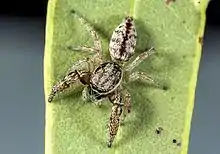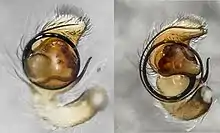Afraflacilla
Afraflacilla is a genus of the spider family Salticidae (jumping spiders).[1][2][3] Most species are distributed in Eastern to Northern Africa (including the Middle East) and Australia, with two species (A. epiblemoides and A. tarajalis) found in Europe. This genus was for a time included in the genus Pseudicius, and the boundaries between both genera are disputed. In 2016 Jerzy Prószyński erected the genus Psenuc for some borderline species.[1][4] The name Afraflacilla is combined from Africa, where most earlier described species were found, and Flacilla Simon, 1901, an obsolete salticid genus now called Flacillula Strand, 1932. This genus name is in turn derived from Aelia Flaccilla, wife of Roman Emperor Theodosius I. Afraflacilla, Pseudicius, Festucula and Marchena are close relatives and form a monophyletic group.
| Afraflacilla | |
|---|---|
 | |
| An undescribed Afraflacilla species, Tennant Creek NT Australia | |
| Scientific classification | |
| Domain: | Eukaryota |
| Kingdom: | Animalia |
| Phylum: | Arthropoda |
| Subphylum: | Chelicerata |
| Class: | Arachnida |
| Order: | Araneae |
| Infraorder: | Araneomorphae |
| Family: | Salticidae |
| Subfamily: | Salticinae |
| Genus: | Afraflacilla Berland & Millot, 1941 |
| Type species | |
| Afraflacilla bamakoi Berland & Millot, 1941 | |
| Species | |
|
42, see text | |

Afraflacilla species have tubercles and bristles (on the sides of the carapace near the eyes and on their legs) which they rub together to make sounds used in courtship and possibly defence. The line of small tubercles (sharp knobs) under the eyes on the side of the carapace are usually visible to the naked eye.[5]
Afraflacilla in Australia
Afraflacilla species in Australia include A. grayorum, A. gunbar, A. huntorum, A. milledgei, A. stridulator, A. vestjensi and A. yeni. In Australia they occupy tree trunks in deserts, savanna woodland and in open sclerophyll forests from south west Western Australia to Cape York Queensland, mostly in warmer regions. There are many undescribed Australian species. Afraflacilla grayorum Grays' stridulating jumping spider, found in northern Australian deserts, was named in honour of Michael and Greta Gray.[6]
The male palpal organ of many Australian Afraflacilla species has a large, circling embolus (inseminating sclerite) and retro-lateral tibial apophysis (side spike). Some undescribed Australian Afraflacilla species have greatly enlarged segments of the first pair of legs, and sometimes massive spurs coming from underneath the tibia and metatarsus (third and second last leg segments). Enlarged leg-one segments are also a feature of Pseudicius, a genus widespread outside Australia.[6]
Species

As of April 2022, the World Spider Catalog accepted the following species:[1]
- Afraflacilla altera (Wesołowska, 2000) – Zimbabwe, South Africa
- Afraflacilla antineae (Denis, 1954) – Algeria
- Afraflacilla arabica Wesołowska & van Harten, 1994 – Egypt, Yemen, Iran, Afghanistan
- Afraflacilla asorotica (Simon, 1890) – Saudi Arabia, Israel, Yemen
- Afraflacilla ballarini Cao & Li, 2016 – China
- Afraflacilla bamakoi Berland & Millot, 1941 – Mali
- Afraflacilla banni Prajapati, Tatu & Kamboj, 2021 – India
- Afraflacilla berlandi Denis, 1955 – Libya
- Afraflacilla bipunctata (G. W. Peckham & E. G. Peckham, 1903) – South Africa
- Afraflacilla braunsi (G. W. Peckham & E. G. Peckham, 1903) – South Africa, Saudi Arabia, Yemen, United Arab Emirates, Turkmenistan
- Afraflacilla datuntata (Logunov & Zamanpoore, 2005) – Afghanistan
- Afraflacilla elegans (Wesołowska & Cumming, 2008) - Zimbabwe, South Africa
- Afraflacilla epiblemoides (Chyzer, 1891) – Central, Eastern Europe, Turkey, Armenia
- Afraflacilla eximia (Wesołowska & Russell-Smith, 2000) – Tanzania
- Afraflacilla fayda (Wesołowska & van Harten, 2010) – United Arab Emirates
- Afraflacilla flavipes (Caporiacco, 1935) – Turkmenistan, Pakistan
- Afraflacilla grayorum Żabka, 1993 – Western Australia, Queensland
- Afraflacilla gunbar Żabka & Gray, 2002 – New South Wales
- Afraflacilla histrionica (Simon, 1902) – South Africa
- Afraflacilla huntorum Żabka, 1993 – Western Australia, Victoria
- Afraflacilla imitator (Wesołowska & Haddad, 2013) – South Africa
- Afraflacilla javanica (Prószyński & Deeleman-Reinhold, 2012) – Java
- Afraflacilla karinae (Haddad & Wesołowska, 2011) – South Africa
- Afraflacilla kraussi (Marples, 1964) – Marshall Is., Cook Is., Samoa
- Afraflacilla mikhailovi (Prószyński, 2000) – Israel
- Afraflacilla mushrif (Wesołowska & van Harten, 2010) – Israel
- Afraflacilla philippinensis (Prószyński, 1992) – Philippines
- Afraflacilla refulgens (Wesołowska & Cumming, 2008) – Zimbabwe
- Afraflacilla reiskindi (Prószyński, 1992) – Borneo
- Afraflacilla risbeci Berland & Millot, 1941 – Senegal
- Afraflacilla roberti (Wesołowska, 2011) – Kenya
- Afraflacilla scenica Denis, 1955 – Niger
- Afraflacilla similis Berland & Millot, 1941 – Senegal
- Afraflacilla spiniger (O. Pickard-Cambridge, 1872) – Egypt to South Sudan
- Afraflacilla stridulator Żabka, 1993 – Western Australia
- Afraflacilla tamaricis (Simon, 1885) – North Africa, Israel, Saudi Arabia, Yemen
- Afraflacilla tarajalis Miñano & Tamajón, 2017 – Spain, Portugal, Morocco
- Afraflacilla venustula (Wesołowska & Haddad, 2009) – South Africa
- Afraflacilla vestjensi Żabka, 1993 – Northern Territory
- Afraflacilla wadis (Prószyński, 1989) – Saudi Arabia, Israel, Yemen
- Afraflacilla yeni Żabka, 1993 – Victoria
- Afraflacilla zuluensis (Haddad & Wesołowska, 2013) – South Africa
References
- Bern, Natural History Museum. "Gen. Afraflacilla Berland & Millot, 1941". World Spider Catalog. Retrieved 7 April 2022.
- Żabka, Marek (1993). "Salticidae (Arachnida: Araneae) of the Oriental, Australian and Pacific Regions. IX.* Genera Afrajlacilla Berland & Millot 1941 and Evarcha Simon 1902". Invertebrate Taxonomy. 7 (2): 279–295. doi:10.1071/it9930279.
- Żabka, Marek (2002). "Salticidae (Arachnida: Araneae) from Oriental, Australian and Pacific regions, XVI. New species of Grayenulla and Afraflacilla". Records of the Australian Museum. 54 (3): 269–274. doi:10.3853/j.0067-1975.54.2002.1366.
- Prószyński, Jerzy (2016). "Delimitation and description of 19 new genera, a subgenus and a species of Salticidae (Araneae) of the world". Ecologica Montenegrina. 7: 4–32. doi:10.37828/em.2016.7.1.
- Whyte, Robert (2017). A Field Guide to Spiders of Australia CSIRO. Australia: CSIRO Publishing. ISBN 9780643107076.
- "ARACHNE.ORG.AU". www.arachne.org.au. Retrieved 2017-05-24.